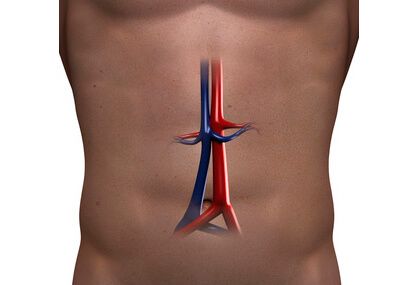Patients with infrarenal abdominal aortic aneurysm (AAA) and ≥ 30 mm neck diameter have 3 times higher risk of type 1A endoleak and 5 times higher risk of rupture at follow up after standard endovascular aneurysm repair (EVAR), as well as lower survival rate. This could tilt the scales against EVAR, or at best call for closer follow up with CT in this subgroup of patients. These findings could also lead to the evolution of prosthesis technology.

The registry included 1257 patients followed up at mean 4 years: 97 (7.7%) had ≥30 mm intrarenal neck diameter and were compared against the 1160 remaining patients (92.3%) with <30 mm diameter. There were no differences between the groups in terms of neck length, angulation, thrombus or calcification. Mean preoperative diameter was 64.6 ± 11.3 mm with ≥30 mm diameter vs 60 ± 11.6 mm in patients with <30-mm neck diameter, which resulted significant (p<0.01).
Read also: Risk of Colonic Ischemia after Abdominal Aortic Aneurysm Repair.
Five patients in the ≥30 mm diameter group (5.2%) and 30 in the <30 mm group (2.6%) developed type 1A endoleak at 4 years (p=0.9). However, after adjusting for length, aneurysm diameter and stent graft oversizing, researchers observed endoleak type 1A risk is far elevated in patients with ≥30 mm neck diameter (HR 3.0; IC 95%, 1.0-9.3; p=0.05).
Aneurysm rupture was also far more frequent in patients with large neck diameter (HR, 5.1; IC 95%, 1.4-19.2; p=0.016).
Survival at 4 years was 61.6% in patients with ≥30 mm neck diameter and 75.2% in patients with smaller neck diameter (p=0.009).
Conclusion
In this study, patients with infrarenal abdominal aortic aneurysm undergoing endovascular repair presenting ≥30 mm neck diameter, have a threefold increased risk of type 1A, endoleak and fivefold increased risk of rupture, and worse survival. These data must be confirmed but still could change the standard of care for this subgroup of patients or demand much closer follow up.
Original title: Patients with large neck diameter have a higher risk of type IA endoleaks and aneurysm rupture after standard endovascular aneurysm repair.
Reference: Nelson F. G. Oliveira et al. J Vasc Surg 2018, article in press.
Subscribe to our weekly newsletter
Get the latest scientific articles on interventional cardiology
We are interested in your opinion. Please, leave your comments, thoughts, questions, etc., below. They will be most welcome.




